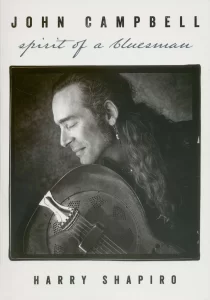A book about the late, transcendentally great blues guitarist and conjure man John Campbell is long overdue. It’s almost inconceivable that no one including yours truly, who wrote the most visceral prose of my career about Campbell for OffBeat Magazine and Details (Magazine) or Keith Spera, who penned a deeply evocative remembrance in OffBeat shortly after John’s untimely death at 41 in 1993—ever took the next step and wrote a book about the life and music of a man whose story is so compelling it almost writes itself.
John’s star burned incandescently bright for just a few short years, when he shot from complete obscurity—to all but the cognoscenti who watched him evolve from playing pickup gigs in his hometown of Shreveport, Louisiana to bus-hopping across Ark-La-Tex as a solo blues guitarist on the crawfish circuit—to become a meteorite blazing across the firmament of the early ’90s blues revival. What happened during that brief journey is the stuff of legend, embellished along the way by both the master storyteller himself and by journalistic co-conspirators who helped him craft his own mythology (guilty as charged).
Enter UK British blues bluff Harry Shapiro, who previously authored books on Hendrix, Clapton and Jack Bruce. Though Shapiro only recently went in search of John Campbell as a biographical subject, he first encountered John in the British blues magazine Blueprint at the peak of his short career in 1993 and immediately bought his three (and only) albums: A Man And His Blues, with Ronnie Earl, on Germany’s CrossCut label (1988); and his incendiary mostly-originals Elektra recordings One Believer (1991) and Howlin’ Mercy (1993), which stunned mainstream outlets like Billboard and Rolling Stone as well as the blues press.
So when that old Blueprint article randomly resurfaced in 2020, and he received the blessing of Campbell superfan Tom Geiger, who runs the Devil In My Closet Facebook page and once intended to write his own book, it was clearly time for Shapiro to get serious about his quest.
And boy, did he get serious! I was just one of hundreds of family members, bandmates, musical collaborators, old friends and fans Shapiro interviewed for his encyclopedic tome, which also cites multiple interviews and reviews from throughout his brief but spectacular career. The sheer volume of material can get overwhelming, and goes down a few rabbit holes, like chasing the backstory of every Shreveport club John ever played. But blues fans are notoriously detailed-obsessed and will likely relish every footnote.
The book also contains some real revelations, from John’s family-tree Huey Long connections to a new detail about his infamous crossroads encounter with the blues at age 16: the head-on collision that drove him through the windshield and nearly cost him his eye was exacerbated by the fact that he was squeezed into the front seat by crutches he was using for a recent leg injury.
So, hats off to Harry Shapiro! Whether you remember John Campbell vividly from his mesmerizing 1993 Jazz Fest performance or are just now learning about him, his book brings the spirit of a bluesman to life as both an ascended master of his instrument and a genuinely humble and generous human being.
“He gave us much more than music,” as John’s dear friend and colleague Dr. John noted during his eulogy at the 1993 memorial service in New York. “He gave himself.”




